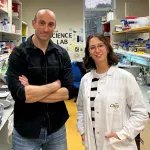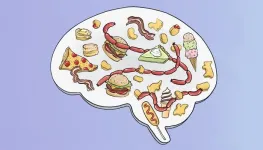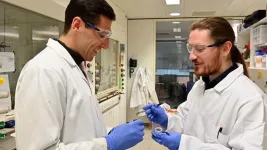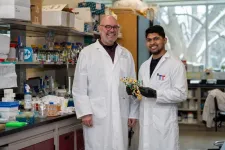(Press-News.org) Time-restricted eating is the latest craze for people looking to lose weight, but whether it works is still the calorie-burning question.
A new study from the University of Mississippi shows that when healthy adults pair an eight-hour eating window with regular exercise, they lose more fat – without sacrificing lean muscle – compared to exercise alone, according to a study released in the International Journal of Obesity, which is published by the Nature Publishing Group.
“We saw that this did lead to more fat loss and reduced body fat percentage over time when healthy adults were following both exercise with time-restricting eating compared to those who were only exercising for at least 4 weeks,” said Nadeeja Wijayatunga, assistant professor of nutrition and hospitality management.
“It is important to note lean mass preservation.”
Wijayatunga and Michael Hays, tactical dietitian and recent Ole Miss graduate, began their study after seeing the dramatic rise in time-restricted eating. Together, they conducted a systematic review and meta-analysis where they analyzed data from 15 studies conducted on time-restricted eating with exercise from the last decade.
Time-restricted eating is one of many diets included in the umbrella term intermittent fasting.
“People like time-restricted eating because they feel it’s easier to adhere to because they don’t have to think too much,” she said. “It’s all about time, not calorie-counting or watching out for certain foods.”
Intermittent fasting has quickly become one of the most popular diets in the United States, with 12% of Americans having tried it, according to the 2023 International Food and Health Survey.
The science surrounding time-restricted eating, however, is still developing, Hays said.
“For some people, this may be a good technique to help with body composition goals,” Hays said. “It's just another tool, but more studies need to come out to really understand how this works in humans.”
While the difference between those who exercised while following a time-restricted diet and those who used exercise alone was slight, the two groups in the studies were already very healthy individuals, Hays said.
“In most cases, these were healthy adults,” Hays said. “They were already physically fit and already had exercise routines. When you already have athletic, lean people and you decrease their body fat percentage, that’s significant.”
Time-restricted eating has been criticized for possibly leading to a loss of lean mass – all the muscles, organs and other tissues that make up the human body.
“We need healthy muscles,” Wijayatunga said. “Muscles are really important for the body and for your metabolism. If we lose muscle, it may impact our metabolic systems, and it just decreases mobility overall.”
In their study, Hays and Wijayatunga found that when paired with exercise, time-restricted eating did not lead to a reduction in lean mass, even for those who lost body fat.
“That’s why you want to couple diet with exercise,” Hays said. “When you’re losing weight, you never want to lose lean tissue. You want to lose fat.”
While the results are promising, Wijayatunga warned that much research is needed to confirm the findings. While this study focused on healthy, active subjects, there is a need to understand how this would impact people who are not in shape and exercising regularly.
“That’s something that needs to be studied,” she said. “What I’d recommend is implementing healthy habits in a way that you – as an individual – can maintain, with guidance from a health care professional.”
END
Study explores how time-restricted eating affects weight loss
Intermittent fasting paired with exercise increases fat loss over activity alone
2025-03-26
ELSE PRESS RELEASES FROM THIS DATE:
Ochsner Health named 2025 Gallup Exceptional Workplace Award winner
2025-03-26
NEW ORLEANS – Ochsner Health, Louisiana’s largest non-profit, academic, multi-specialty, healthcare delivery system, has been awarded the 2025 Gallup Exceptional Workplace Award (GEWA) for employee engagement. This award recognizes the most engaged companies in the world and highlights Ochsner’s continued dedication to setting a standard of excellence in patient care and the workplace.
"Ochsner Health is honored to receive this recognition," said Pete November, chief executive officer, Ochsner Health. "Our commitment to fostering a supportive and dynamic workplace for our team members is directly ...
Researchers have discovered a new mechanism for rapid liver regeneration triggered by glutamate
2025-03-26
Research conducted by the National Cancer Research Centre (CNIO), published today in ‘Nature’, reveals a mechanism in mice that is triggered just minutes after acute liver damage occurs.
This finding opens up avenues for future treatments of serious liver damage to include a diet enriched with the amino acid glutamate.
Glutamate supplementation can promote liver regeneration and benefit patients in recovery following hepatectomy or awaiting a transplant, the authors write in ‘Nature’.
Activating liver regeneration is key to treating diseases that involve severe liver damage, which are becoming increasingly frequent and are associated ...
Scientists discover why obesity takes away the pleasure of eating
2025-03-26
The pleasure we get from eating junk food — the dopamine rush from crunching down on salty, greasy French fries and a luscious burger — is often blamed as the cause of overeating and rising obesity rates in our society.
But a new study by scientists at the University of California, Berkeley, suggests that pleasure in eating, even eating junk food, is key for maintaining a healthy weight in a society that abounds with cheap, high-fat food.
Paradoxically, anecdotal evidence suggests that people with obesity may take less pleasure in eating than those of normal weight. Brain scans of obese individuals ...
How cells respond to stress is more nuanced than previously believed
2025-03-26
CLEVELAND—The body’s cells respond to stress—toxins, mutations, starvation or other assaults—by pausing normal functions to focus on conserving energy, repairing damaged components and boosting defenses.
If the stress is manageable, cells resume normal activity; if not, they self-destruct.
Scientists have believed for decades this response happens as a linear chain of events: sensors in the cell “sound an alarm” and modify a key protein, which then changes a second protein that slows or shuts down the cell’s normal function.
But in a new study published today in the journal Nature, researchers at Case Western Reserve University have discovered a ...
A new method to recycle fluoride from long-lived PFAS chemicals
2025-03-26
UNDER EMBARGO UNTIL: 16:00 GMT / 12 NOON ET WEDNESDAY 26 MARCH 2025
A new method to recycle fluoride from long-lived PFAS chemicals
Images available via the link in the notes section.
Oxford Chemistry researchers have developed a method to destroy fluorine-containing PFAS (sometimes labelled ‘forever chemicals’) while recovering their fluorine content for future use. The results have been published today (26 March 2025) in Nature.
PFAS – which stands for poly- and perfluoroalkylated substances – have been produced in large ...
A breakthrough moment: McMaster researchers discover new class of antibiotics
2025-03-26
The last time a new class of antibiotics reached the market was nearly three decades ago — but that could soon change, thanks to a discovery by researchers at McMaster University.
A team led by renowned researcher Gerry Wright has identified a strong candidate to challenge even some of the most drug-resistant bacteria on the planet: a new molecule called lariocidin. The findings were published in the journal Nature on March 26, 2025.
The discovery of the all-new class of antibiotics responds to a critical need for new antimicrobial ...
The devastating human impact on biodiversity
2025-03-26
Humans are having a highly detrimental impact on biodiversity worldwide. Not only is the number of species declining, but the composition of species communities is also changing. These are the findings of a study by Eawag and the University of Zurich published in the scientific journal Nature. It is one of the largest studies ever conducted on this topic.
Biological diversity is under threat. More and more plant and animal species are disappearing worldwide, and humans are responsible. Until now, however, there has been no synthesis of the extent of human intervention in nature and whether the effects can be found everywhere in the world ...
Calorie-free sweeteners can disrupt the brain’s appetite signals
2025-03-26
Compared to sugar, consuming sucralose—a widely used sugar substitute—increases activity in the hypothalamus, a brain region that regulates appetite and body weight, according to a new USC study. Sucralose also changes how the hypothalamus communicates with other brain regions, including those involved in motivation. The study was just published in the journal Nature Metabolism.
About 40% of Americans regularly consume sugar substitutes, usually as a way to reduce calories or sugar intake. “But are these substances actually helpful for regulating ...
Researchers achieve quantum computing milestone, realizing certified randomness
2025-03-26
In a new paper in Nature, a team of researchers from JPMorganChase, Quantinuum, Argonne National Laboratory, Oak Ridge National Laboratory and The University of Texas at Austin describe a milestone in the field of quantum computing, with potential applications in cryptography, fairness and privacy.
Using a 56-qubit quantum computer, they have for the first time experimentally demonstrated certified randomness, a way of generating random numbers from a quantum computer and then using a classical supercomputer to prove they are truly random and freshly generated. This could pave the way towards the use of quantum computers for a practical task unattainable through ...
Lasso-shaped antibiotic co-developed by UIC evades standard drug resistance
2025-03-26
A small molecule shaped like a lasso may be a powerful tool in the fight against infectious diseases, according to a new study in Nature co-authored by University of Illinois Chicago researchers.
Lariocidin, a peptide made by bacteria living in soil, was effective against several different microbes responsible for deadly infections. UIC researchers working with collaborators at McMaster University in Canada determined how the new antibiotic works and why the drug evades bacterial resistance.
“The holy grail in the field is to find an antibiotic that binds to a new site target, has a novel mechanism of action and has ...
LAST 30 PRESS RELEASES:
Injectable breast ‘implant’ offers alternative to traditional surgeries
Neuroscientists devise formulas to measure multilingualism
New prostate cancer trial seeks to reduce toxicity without sacrificing efficacy
Geometry shapes life
A CRISPR screen reveals many previously unrecognized genes required for brain development and a new neurodevelopmental disorder
Hot flush treatment has anti-breast cancer activity, study finds
Securing AI systems against growing cybersecurity threats
Longest observation of an active solar region
Why nail-biting, procrastination and other self-sabotaging behaviors are rooted in survival instincts
Regional variations in mechanical properties of porcine leptomeninges
Artificial empathy in therapy and healthcare: advancements in interpersonal interaction technologies
Why some brains switch gears more efficiently than others
UVA’s Jundong Li wins ICDM’S 2025 Tao Li Award for data mining, machine learning
UVA’s low-power, high-performance computer power player Mircea Stan earns National Academy of Inventors fellowship
Not playing by the rules: USU researcher explores filamentous algae dynamics in rivers
Do our body clocks influence our risk of dementia?
Anthropologists offer new evidence of bipedalism in long-debated fossil discovery
Safer receipt paper from wood
Dosage-sensitive genes suggest no whole-genome duplications in ancestral angiosperm
First ancient human herpesvirus genomes document their deep history with humans
Why Some Bacteria Survive Antibiotics and How to Stop Them - New study reveals that bacteria can survive antibiotic treatment through two fundamentally different “shutdown modes”
UCLA study links scar healing to dangerous placenta condition
CHANGE-seq-BE finds off-target changes in the genome from base editors
The Journal of Nuclear Medicine Ahead-of-Print Tip Sheet: January 2, 2026
Delayed or absent first dose of measles, mumps, and rubella vaccination
Trends in US preterm birth rates by household income and race and ethnicity
Study identifies potential biomarker linked to progression and brain inflammation in multiple sclerosis
Many mothers in Norway do not show up for postnatal check-ups
Researchers want to find out why quick clay is so unstable
Superradiant spins show teamwork at the quantum scale
[Press-News.org] Study explores how time-restricted eating affects weight lossIntermittent fasting paired with exercise increases fat loss over activity alone








